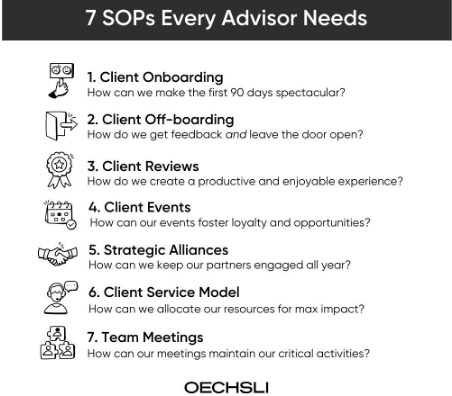People often ask us – what makes an elite team “elite.” Put simply, they live in a constant state of self-improvement, making seemingly small changes to the way they attract and service affluent clients. For example, an elite team might decide that all new clients should get a technology walkthrough to help them understand the tools at their disposal. This is a small adjustment, but one of many they’ll make this year. Over time, this creates a competitive advantage.
One of the challenges in replicating this constant state of self-improvement is the tendency for good ideas of today to become forgotten ideas of tomorrow. It doesn’t take much to drop these types of initiatives … a market correction, a sick staff member or a busy period in your business.
This is where standard operating procedures come into play. They help mitigate the idea-of-the-moment syndrome by creating written guidelines for key team functions. So where do we begin? The following are seven key SOPs that serve as a great starting point for systematizing your business:

Atul Gawande, a renowned surgeon and author, has emphasized the importance of keeping checklists and SOPs simple. In his book The Checklist Manifesto, he notes that the most effective checklists are concise and focused on the most important steps or tasks. They should be easy to use and understand, even in high-pressure or complex situations.
Gawande notes that overly complex checklists can be counterproductive, as they may be ignored or lead to confusion and errors. He recommends checklists be developed through collaboration with frontline workers and tested in real-world situations to ensure they are practical and effective.
In the case of financial teams, the team leader may be responsible for creating some of these SOPs, but other team members should be heavily involved. Assign each team member ownership of an SOP that is linked to their area of responsibility. This will help them feel invested in the process and motivated to execute it.
SOPs are living, breathing documents. It’s important to add them, keep them current, and inspect their usage. Over time, you’re building a competitive advantage over teams that fall victim to the inconsistency that comes with poor planning.
Stephen Boswell is a partner with The Oechsli Institute, a firm that specializes in research and training for the financial services industry. @StephenBoswell www.oechsli.com

